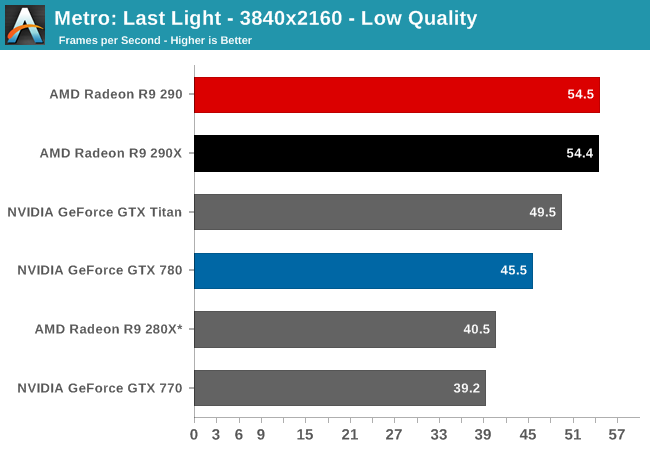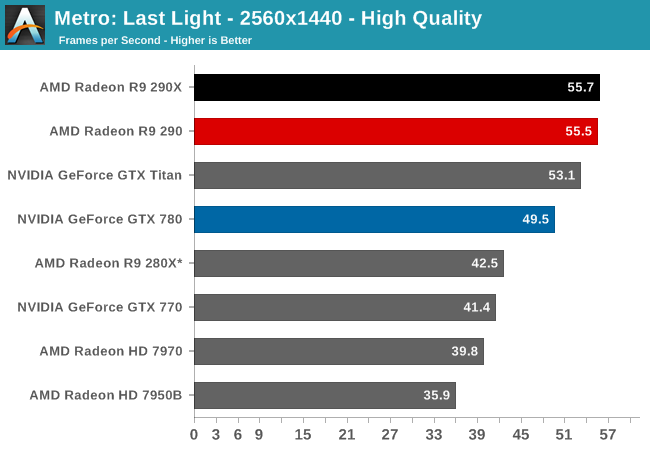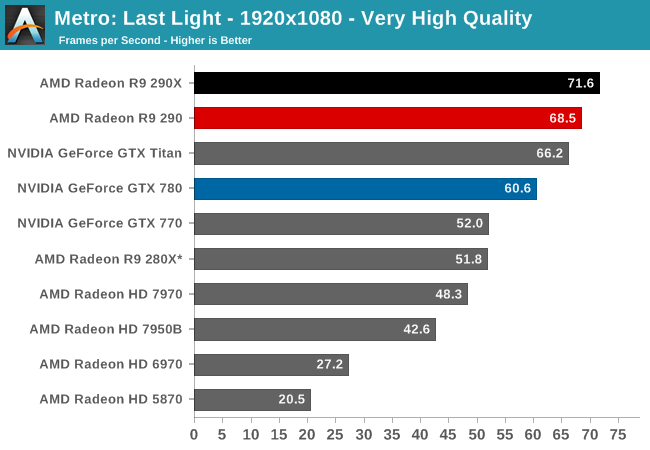The AMD Radeon R9 290 Review
by Ryan Smith on November 5, 2013 12:01 AM EST- Posted in
- GPUs
- AMD
- Radeon
- Hawaii
- Radeon 200
Metro: Last Light
As always, kicking off our look at performance is 4A Games’ latest entry in their Metro series of subterranean shooters, Metro: Last Light. The original Metro: 2033 was a graphically punishing game for its time and Metro: Last Light is in its own right too. On the other hand it scales well with resolution and quality settings, so it’s still playable on lower end hardware.



For the bulk of our analysis we’re going to be focusing on our 2560x1440 results, as monitors at this resolution will be what we expect the 290 to be primarily used with. A single 290 may have the horsepower to drive 4K in at least some situations, but given the current costs of 4K monitors that’s going to be a much different usage scenario. The significant quality tradeoff for making 4K playable on a single card means that it makes far more sense to double up on GPUs, given the fact that even a pair of 290Xs would still be a fraction of the cost of a 4K, 60Hz monitor.
With that said, there are a couple of things that should be immediately obvious when looking at the performance of the 290.
- It’s incredibly fast for the price.
- Its performance is at times extremely close to the 290X
To get right to the point, because of AMD’s fan speed modification the 290 doesn’t throttle in any of our games, not even Metro or Crysis 3. The 290X in comparison sees significant throttling in both of those games, and as a result once fully warmed up the 290X is operating at clockspeeds well below its 1000MHz boost clock, or even the 290’s 947MHz boost clock. As a result rather than having a 5% clockspeed deficit as the official specs for these cards would indicate, the 290 for all intents and purposes clocks higher than the 290X. Which means that its clockspeed advantage is now offsetting the loss of shader/texturing performance due to the CU reduction, while providing a clockspeed greater than the 290X for the equally configured front-end and back-end. In practice this means that 290 has over 100% of 290X’s ROP/geometry performance, 100% of the memory bandwidth, and at least 91% of the shading performance.
So in games where we’re not significantly shader bound, and Metro at 2560 appears to be one such case, the 290 can trade blows with the 290X despite its inherent disadvantage. Now as we’ll see this is not going to be the case in every game, as not every game GPU bound in the same manner and not every game throttles on the 290X by the same degree, but it sets up a very interesting performance scenario. By pushing the 290 this hard, and by throwing any noise considerations out the window, AMD has created a card that can not only threaten the GTX 780, but can threaten the 290X too. As we’ll see by the end of our benchmarks, the 290 is only going to trail the 290X by an average of 3% at 2560x1440.
Anyhow, looking at Metro it’s a very strong start for the 290. At 55.5fps it’s essentially tied with the 290X and 12% ahead of the GTX 780. Or to make a comparison against the cards it’s actually priced closer to, the 290 is 34% faster than the GTX 770 and 31% faster than the 280X. AMD’s performance advantage will come crashing down once we revisit the power and noise aspects of the card, but looking at raw performance it’s going to look very good for the 290.










295 Comments
View All Comments
DMCalloway - Wednesday, November 6, 2013 - link
Not sure how to interpret your analogy. Heat is measured in watts (energy) needing dissipation. This card is running up to 95*C while drawing around 50 more watts of power than a 780 . The 780 while drawing 50 less watts of power is running up to 80*C. Out of the gate the heat sink on the R290 is going to have to be at LEAST 20% more effective than the current 780 heat sink, and this thermal excess is still being pumped into the case.Galidou - Friday, November 15, 2013 - link
Well as I can see you are rather unfamiliar with power leakage due to temperature... anyway I won't get into the subject, I'll let you google it. Getting a card to run a lot cooler at the same frequencies can reduces power usage depending on how bad it affects certain node.A 20 degree celsius difference can have a great impact on power usage which I think might turn the tide around. In 28nm design, power leakage has been a bigger problem than before, probably a reason why Nvidia has been using better reference coolers thus, enhancing the performance/watt for the last generations of video cards.
That is the basis of my previous analogy.
TrantaLocked - Tuesday, November 5, 2013 - link
With the card in the case, with headphones on, with sounds/music from the game playing, hearing the 290 or any card would be tough. I know what loud video cards sound like (I owned the 4890 with a single fan design, and I always ran the fan at manual 40%-50% speed for gaming), and when playing a game with headphones the sound is barely audible and definitely not distracting.Calinou__ - Tuesday, November 5, 2013 - link
I have a reference 570 in a sound dampened case and a headset and I can easily hear it, even at idle (40% fan speed)... and I guess the R9 290 is more noisy.Galidou - Tuesday, November 5, 2013 - link
A reference 570 if not cleaned regularly(once every two months) goes easily up to 62 db. GTX 480 went up to 64 db(brand new) and Nvidia fans praised it even if AMD fans were saying it was loud, nothing new in here... Nvidia fans once said that 64 db is ''nothing'' for a good performing card... Look at them now speaking and whining about the same situation, really fun to see the tides turn around...That was in a time when reference coolers where much more used and represented a MUCH bigger % of the market, I would never buy an AMD reference cooled card. Nvidia fans started to care about noise and temperature when they got the 600 series out and for the first time had an advantage.
Finally - Tuesday, November 5, 2013 - link
Whoever buys a card with the default fan? Get one with a custom design and problem solved. How hard is that?Aikouka - Tuesday, November 5, 2013 - link
Anyone that buys it right now? =Pkmmatney - Tuesday, November 5, 2013 - link
I used to think that too, until I actually bought a loud HD4890. I ended up having to get an Accelero, which made it dead quiet. My current NVidia based card is also really loud, but I fixed that buy underclocking it most of the time. Really loud cards are just not fun to deal with. I'd wait for third party cards to come out with better cooling solutions.hoboville - Tuesday, November 5, 2013 - link
Except that it's hot, noisy, and basically pointless to overclock because it's as loud as a medium party without music. So as it is, it's a bad card.However, since it's only $400, one could go out and buy a water cooling setup and have a card faster than the 290x for about the same or less money. For Titan money, you could get a second 290 and add some more rads to your setup. The thing is...if you do want to OC (and why wouldn't you with water cooling?), you'll have to dissipate over 800 watts of heat...
Slomo4shO - Tuesday, November 5, 2013 - link
Well done AMD. Competition at its finest!